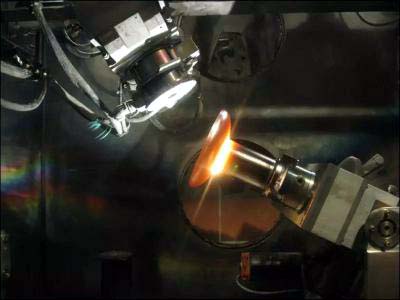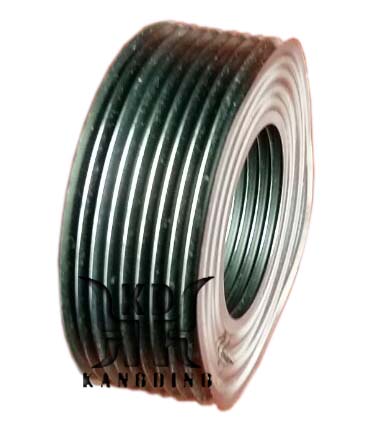TC4 Titanium Alloy Parts Machining And Welding Process Notes
Common welding methods for titanium and titanium alloys include: argon arc welding, submerged arc welding, vacuum electron beam welding, and the like.
Tungsten argon arc welding is used for thicknesses below 3 mm, and argon arc welding is performed for more than 3 mm. The purity of argon is not less than 99.99%, and the content of air and water vapor in argon is strictly controlled.
 At present, for TC4 titanium alloy, argon arc welding or plasma arc welding is often used for welding, but both methods need to be filled with welding materials.
At present, for TC4 titanium alloy, argon arc welding or plasma arc welding is often used for welding, but both methods need to be filled with welding materials.
Due to the limitation of shielding gas, purity and effect, the oxygen content of the joint increases, the strength decreases, and the deformation after welding is large.
Electron beam welding and laser beam welding are used. The following is a description of the precision welding and precautions for the TC4 titanium alloy.
1. Weld hole problem
The pores in the weld are the most common defects in welded titanium alloys, and hydrogen and oxygen present in the arc region of the metal to be welded are the main causes of pores. TC4 titanium alloy electron beam welding has few vent defects in the weld. To this end, research is focused on the process factors for forming pores in laser welded welds.
It can be seen from the test results that the pores in the weld are closely related to the energy of the weld line during laser welding. If the welding line energy is moderate, there are only a very small number of pores or even no pores in the weld. If the line energy is too large or too small, serious pore defects will occur in the weld. In addition, whether there are porosity defects in the weld is also related to the wall thickness of the weldment. Comparing the test results of the sample, it can be seen that as the wall thickness of the weld increases, the probability of occurrence of pores in the weld increases.
2, the internal quality of the weld
Sample of titanium plate butt welding by electron beam welding and laser welding to examine the internal quality of the weld. After testing, the internal quality of the weld is X-ray flawed, up to GB3233-87 Level II requirements. No cracks appear on the surface and inside of the weld, the appearance of the weld is well formed and the color is normal.
3. Welding depth and its fluctuation
Titanium alloy is used as an engineering component, which has certain requirements on the welding depth, otherwise it cannot meet the component strength requirements;
Moreover, in order to achieve precision welding, it is necessary to control the weld depth fluctuation. To this end, two pairs of butt test rings were welded by electron beam welding and laser welding, respectively. After welding, the test ring was longitudinally and laterally dissected to investigate the weld depth and weld depth fluctuations. The results show that the average weld depth of the electron beam welding weld can reach 2.70mm or more. The welding depth fluctuation range is -5.2~+6.0%, not exceeding ±10%; The average weld depth of the laser welded weld is about 2.70mm, and the weld depth fluctuates from -3.8 to +5.9%, not exceeding ±10%.
4, joint deformation analysis
The butt test ring is used to inspect the joint welding deformation, and the radial and axial deformation of the butt test ring is detected. The results show that the deformation of electron beam welding and laser welding is very small. The radial shrinkage deformation of electron beam welding is f 0.05~f 0.09mm, and the axial shrinkage is 0.06~0.14mm; The radial shrinkage deformation of laser welding is f 0.03~f 0.10mm, and the axial shrinkage deformation is 0.02~0.03mm.
5, Titanium weld seam analysis
After chemical detection, the weld structure is a+b, and the microstructure is columnar crystal + equiaxed crystal. A small amount of lath martensite appears, the grain size is close to the matrix, the heat affected zone is narrow, and the morphology and characteristics are ideal.
After research, it can be concluded that: For TC4 titanium alloy, whether it is laser welding or electron beam welding, as long as the process parameters are matched properly, the internal quality of the weld can meet the national standard GB3233-87II weld requirements. Realize precision welding of TC4 titanium alloy; The appearance of the weld is well formed and the color is normal; the weld height is small, and no defects such as undercuts, dents and surface cracks are generated.

Tungsten argon arc welding is used for thicknesses below 3 mm, and argon arc welding is performed for more than 3 mm. The purity of argon is not less than 99.99%, and the content of air and water vapor in argon is strictly controlled.

Due to the limitation of shielding gas, purity and effect, the oxygen content of the joint increases, the strength decreases, and the deformation after welding is large.
Electron beam welding and laser beam welding are used. The following is a description of the precision welding and precautions for the TC4 titanium alloy.
1. Weld hole problem
The pores in the weld are the most common defects in welded titanium alloys, and hydrogen and oxygen present in the arc region of the metal to be welded are the main causes of pores. TC4 titanium alloy electron beam welding has few vent defects in the weld. To this end, research is focused on the process factors for forming pores in laser welded welds.
It can be seen from the test results that the pores in the weld are closely related to the energy of the weld line during laser welding. If the welding line energy is moderate, there are only a very small number of pores or even no pores in the weld. If the line energy is too large or too small, serious pore defects will occur in the weld. In addition, whether there are porosity defects in the weld is also related to the wall thickness of the weldment. Comparing the test results of the sample, it can be seen that as the wall thickness of the weld increases, the probability of occurrence of pores in the weld increases.
2, the internal quality of the weld
Sample of titanium plate butt welding by electron beam welding and laser welding to examine the internal quality of the weld. After testing, the internal quality of the weld is X-ray flawed, up to GB3233-87 Level II requirements. No cracks appear on the surface and inside of the weld, the appearance of the weld is well formed and the color is normal.
3. Welding depth and its fluctuation
Titanium alloy is used as an engineering component, which has certain requirements on the welding depth, otherwise it cannot meet the component strength requirements;
Moreover, in order to achieve precision welding, it is necessary to control the weld depth fluctuation. To this end, two pairs of butt test rings were welded by electron beam welding and laser welding, respectively. After welding, the test ring was longitudinally and laterally dissected to investigate the weld depth and weld depth fluctuations. The results show that the average weld depth of the electron beam welding weld can reach 2.70mm or more. The welding depth fluctuation range is -5.2~+6.0%, not exceeding ±10%; The average weld depth of the laser welded weld is about 2.70mm, and the weld depth fluctuates from -3.8 to +5.9%, not exceeding ±10%.
4, joint deformation analysis
The butt test ring is used to inspect the joint welding deformation, and the radial and axial deformation of the butt test ring is detected. The results show that the deformation of electron beam welding and laser welding is very small. The radial shrinkage deformation of electron beam welding is f 0.05~f 0.09mm, and the axial shrinkage is 0.06~0.14mm; The radial shrinkage deformation of laser welding is f 0.03~f 0.10mm, and the axial shrinkage deformation is 0.02~0.03mm.
5, Titanium weld seam analysis
After chemical detection, the weld structure is a+b, and the microstructure is columnar crystal + equiaxed crystal. A small amount of lath martensite appears, the grain size is close to the matrix, the heat affected zone is narrow, and the morphology and characteristics are ideal.
After research, it can be concluded that: For TC4 titanium alloy, whether it is laser welding or electron beam welding, as long as the process parameters are matched properly, the internal quality of the weld can meet the national standard GB3233-87II weld requirements. Realize precision welding of TC4 titanium alloy; The appearance of the weld is well formed and the color is normal; the weld height is small, and no defects such as undercuts, dents and surface cracks are generated.






